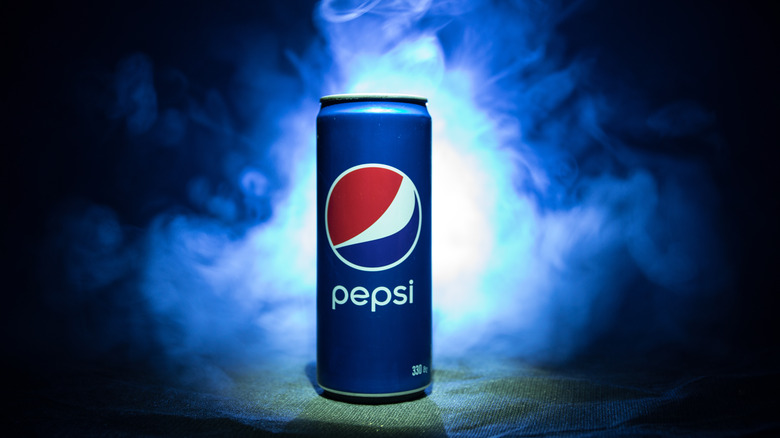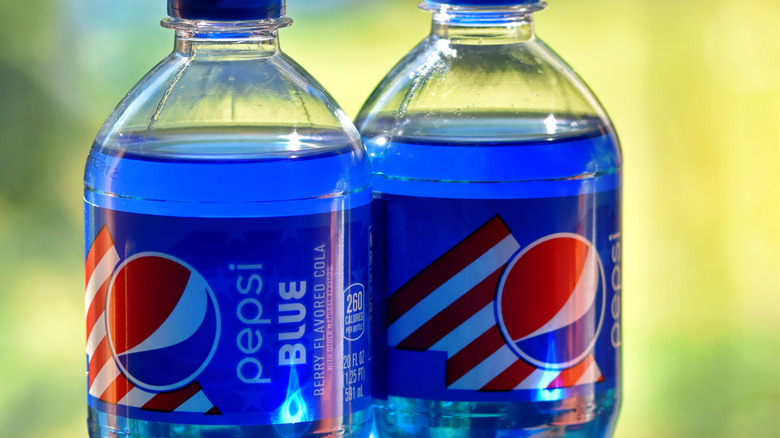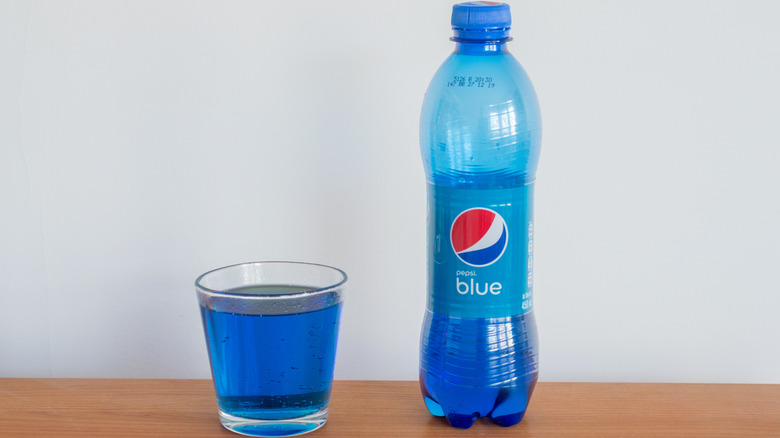The Discontinued Pepsi Flavor We Aren't Getting Back Anytime Soon
Competition is good for business – at least, that's what they say. But sometimes companies get so caught up in the competition that, in fits of haste and eagerness, they shoot themselves in the foot. So went the story of Pepsi Blue. The early-2000s marked a critical point in the decades-long battle for soft drink supremacy between Pepsi and Coca-Cola. Pepsi's reputation had taken a hit just a few years before with the letdown of Crystal Pepsi, one of the 1990s biggest food failures. The company grew desperate in 2002 when Coca-Cola announced the impending release of Vanilla Coke, which Pepsi feared could deal a significant blow to its business. Eager to compete, Pepsi executives came up with a plan.
For inspiration, they turned to the only logical place: Mountain Dew, a brand under the PepsiCo umbrella that saw tremendous success in 2001 with the release of Code Red, a cherry-flavored version with a violently red hue. It had been a big hit with teenagers, and Pepsi executives figured they could capture more of that market if they released another neon beverage. After running through more than 100 concepts and testing the market through teen focus groups, Pepsi released Pepsi Blue, a berry-flavored soda with a color unsettlingly close to Windex. It hit the market in May 2002, one day ahead of the release of Vanilla Coke. Two years later, it was gone.
Pepsi Blue was aggressively marketed to teens
The release of Pepsi Blue was accompanied by great fanfare, with several expensive marketing moves targeting the teenage demographic. For a series of televised commercials, Pepsi recruited the biggest name in early-2000s entertainment: Britney Spears. Oh, but they were just getting started. They secured product placements in multiple movies, including the Mark Wahlberg-led remake of "The Italian Job" and "Garfield: The Movie." Pepsi Blue also became a sponsor of various sporting events such as the X Games and India's 2003 Cricket Cup.
In a particularly interesting (though ill-advised) move, Pepsi attempted something akin to modern influencer marketing. Today, social media is arguably the most important avenue for advertising, which is why you see so many Instagram, TikTok, and YouTube stars partnering with brands to promote their products. Those platforms didn't exist in 2002, but early online forums did. Pepsi had a team of employees create online posts pretending to be customers raving about Pepsi Blue. This backfired, as the fake posts were not particularly convincing. Internet users caught onto the scheme, and instead of coming off as cool and trendy, Pepsi came off as a try-hard. All told, Pepsi dumped millions of dollars into marketing Pepsi Blue, but it didn't amount to much in the end.
Pepsi Blue was discontinued in 2004, but made a brief comeback
Despite Garfield's best efforts to push the stuff, Pepsi Blue became a flop. Teenagers did enjoy it, generally praising the berry flavor. But when you market your product entirely to teenagers, you cut out a substantial portion of the population — adults — which also happens to be the portion with money to spend. Older demographics had much less favorable opinions about Pepsi Blue, criticizing the aggressively sweet, artificial flavor.
Sales of Pepsi Blue trended downward at an alarming rate. The soda debuted halfway through 2002 and, in the second half of the year, sold 17 million cases. In 2003, Pepsi Blue's first full year on the market, it sold just 5 million cases. The following year, it was discontinued in most markets. In 2021, it made a brief comeback for a limited summertime run before fading away again. As for the product Pepsi was so anxious to compete with, Vanilla Coke, it ousted Pepsi Blue more than five-fold, yet was pulled from shelves in 2005. Vanilla Coke has since returned, while Pepsi Blue has faded ever further into the past.


